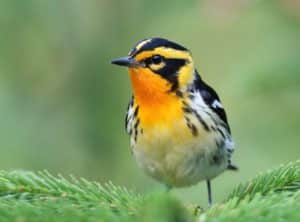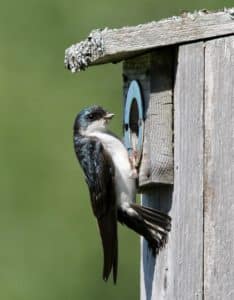The greater Wildlands area (including Craig Brook National Fish Hatchery, Alamoosook Lake and Dead River, Craig Pond, Hothole Pond and wetlands along Moosehorn Stream) hosts a wonderful variety of habitats, from blueberry-covered ledges atop Great Pond Mountain or Flag Hill to the mature mixed forests of Craig Brook National Fish Hatchery, from beaver ponds along Hothole Pond Trail in the Wildlands to the quiet shores of Dead River. There are more than 30 miles of trails here and very accessible waters—take a hike, bike or ski, or bring a kayak—but don’t forget your binoculars!
Download our bird checklist:
Birds of Great Pond Mountain Wildlands and Environs
When to go:
While most birders prefer spring migration (which peaks in late May here) for the biggest and brightest variety of birds, you can find birds in the Wildlands area any time of year. June and July are wonderful for breeding birds. Fall migration in September and October brings species like fox sparrow and blackpoll warbler down from the north, and is a great time to watch for peregrine falcons from Great Pond Mountain or spot ducks (and hunters) on the Dead River. Spend time on Valley Road in November/December, and you may see a lively flock of snow buntings, while winter brings irruptive species like pine siskin, common redpoll and crossbills. You might even get lucky and spot a snowy owl atop Flag Hill or Flying Moose Mountain.

Blackburnian warbler by Leslie Clapp
Where to go:
The oldest forest in the area can be found at 135-acre Craig Brook National Fish Hatchery (the nation’s oldest public Atlantic salmon hatchery), where towering 150-year-old pines, hemlocks and oaks attract blackburnian and pine warblers, barred owls, pileated woodpeckers and Eastern wood-pewees. You can hike from Alamoosook Lake to Craig Pond on the Hatchery’s network of nature trails. Maps are available at the Visitor Center. In contrast, the 5,100-acre Great Pond Mountain Wildlands was logged heavily by a previous owner in the late 1990s, and habitats in the Wildlands are growing and changing rapidly. Early successional species of old fields and young forests—such as indigo buntings and chestnut-sided warblers—are still found in the Wildlands, but are slowly moving out as some fields are allowed to grow in, and forest canopy closes. Beavers move up and down Hothole Brook and tributaries, creating habitat for swallows, ducks, woodpeckers, and northern waterthrush and leaving wet meadows in their wakes. Wildlands managers also create and enhance habitat, from brushpiles for winter wrens, to birdhouses for swallows, bluebirds and chickadees, to standing dead snags that will house owls and woodpeckers. More than 30 miles of trails and paths in the Wildlands allow for birding on foot, by bike, or on skis or snowshoes in all seasons. Lakes and ponds in the area are easily accessible. Bring a kayak or canoe to Craig Brook Hatchery and paddle the shores of Alamoosook Lake and the Dead River to watch loons, osprey and eagles, or put in on peaceful Craig Pond to spot kingfishers and common mergansers. A trip down Moosehorn Stream to Hothole Pond (put in at the bridge on Bald Mountain Road) is a bit more adventurous, but you’ll see and hear a plethora of wetland species, from herons to rails and warblers to waterfowl.
For some suggested bird walks and paddles, download:
Wildlands Birding Adventures , and the Wildlands maps!
What to Bring: Binoculars, a Wildlands map, bug spray, sunscreen, extra layers, a hat and plenty of water are musts! A compass can also be helpful. Trails are often longer than you might expect, and it can be easy to get turned around at junctions. Bring your smartphone to use eBird, but keep in mind there are many locations where reception is spotty – so bring a notebook and pencil too!
How YOU can Help:

Tree swallow by Leslie Clapp
Please share your Wildlands area bird observations via eBird, or by emailing info@greatpondtrust.org. Your sightings are important, and will help us, our partners and state and federal agencies gain understanding about where birds are nesting and foraging, during breeding season and migration. Knowing more about birds will help us make better management decisions to benefit birds and other wildlife. Using eBird, you can record birding observations in the Wildlands area and all around the world. You can also find birding hotspots worldwide. The Wildlands Dead River Parcel and Hothole Valley Parcel are hotspots on eBird, and you can see which species have already been observed there. eBird’s website has great tutorials to help you set up an account, navigate the website, and submit your bird lists. Of course, you’ll want to use the app if you have a smartphone! There is a separate Maine Bird Atlas page on eBird, for those who wish to add their sightings to this project, through the Maine eBird Portal. To record or see sightings in the Wildlands area on the Maine Bird Atlas, visit the Orland NE block. You can explore confirmed and possible breeding species all through Maine, and there is also a Winter Atlas. To learn more about the Maine Bird Atlas, click HERE. Please also consider:
- “Adopt” a block during the Breeding Bird Atlas, now thru 2022. Go to Maine Bird Atlas to learn more.
- “Adopt” another GPMCT property to monitor birds
- Help us monitor and clean our Wildlands bird houses
- Sign up for our once-yearly Woodcock or Nightjar surveys in the Wildlands
- Share photos of birds for GPMCT to use
- Attend a GPMCT bird walk
- Spread the word!
Birding Links:
- Downeast Audubon
- Maine Audubon
- Fields Pond Audubon Center, Holden
- eBird
- All About Birds, Cornell Lab of Ornithology
